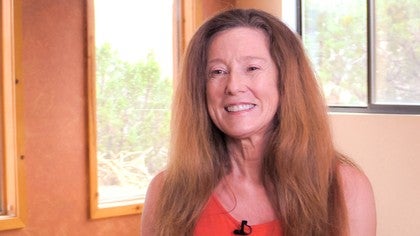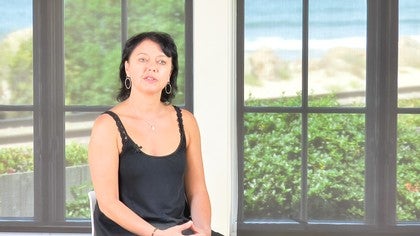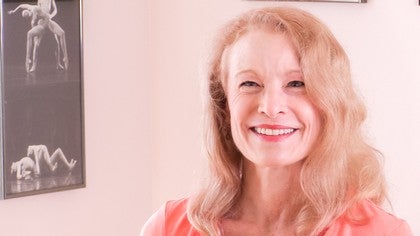Discussion #1516
Mary Anne Newhall on Eve
Description
About This Video
Transcript
Read Full Transcript
Well, I'm Marianne Santos, new hall and I had the great privilege to work with Eve Gentry, uh, in the reconstruction of what I think is one of her signature solos tenant of the street that she choreographed in 1938. Um, and she had worked with Michelle Larson and reconstructing the work and I believe 1988. And then, um, in 1993, she was asked to contribute that work to a gala in New York City at LaGuardia High School. That brought together a great generation of dance pioneers that were part of something called the new dance group. And Eve was part of that group. Uh, the new dance group. We're committed to making dances that mattered. They made dances about social social issues and a tenant of the street about a homeless woman was part of that work. At the same time, Eve was a member of the new dance group.
She was a member of Hanya Holmes original dance company. Hanya Holm went on to have a great fame in Broadway. Um, but in those early years, she was bringing ideas of this thing called modern dance from Germany to the United States. And I'm so grateful to have this chance to talk about dance and Eve, um, you know, it was a great gift to be able to know eve and to work with her. And I was so inspired by that time.
I have to say that it chartered my own course as a dance historian, um, beginning with my time with her. And, um, I was telling Michelle that because eve was up there in year, she was in her eighties when we worked on tenant of the street. A lot of my return rehearsal time with her, there was time in the studio and she could be very exacting down to the little finger, what are you doing with your right little finger, um, and do that jump again and let's see that run and I don't believe you. Um, those sorts of things. Uh, and aside from that time in the studio, I spent a lot of time with her in her home because she couldn't be in the studio for that long. At that age, I'm talking about dance and, uh, how dance was important to her. And I think that talking about her police work and talking about her dance worker intertwined that for her it was all part of this great love of dance. And I was lucky enough. Well, the first part is I didn't know enough to ask the questions that I wish I could have asked because I think it's always that way time.
Um, and he passed away before I could ask all the questions I wanted to ask, but I was so fortunate to receive some of her papers, things to Michelle Larson. Um, and the good part is eve was a saver. Uh, her programs, photographs, her own notes, um, were all among those papers. And she, what comes across in seeing her writing and really thinking about her story is that she was absolutely consumed by this calling to dance. It was a way of life for her from early on. She found this love of dance and it directed with her indomitable will, uh, uh, the choices that she made in her life. Um, and it was not easy to become a dancer in those days coming from where she was coming from. And, um, and yet she found her way. Uh, and I think it's a really inspiring story. I certainly talk about her when I teach and I see this generation going, wow, somebody cared that much about this dance thing to work so hard to make it happen. Um, and I'm sure Michelle has spoken about her, uh, Rehab work with, uh, Joseph and Clara polities and how that plays a role.
Certainly played a role in her, um, teaching of Hanya Holm material. It certainly, you know, I see so many places where her dance work in her, uh, therapeutic work cross over, especially in her use of improvisation and that idea of being in the moment in the dance. So, and the history of dance modernism, we use the term the big four. Oh. And those were the folks that in 19, actually starting in the mid 1930s at a place called Bennington that, um, uh, was in, is still in Vermont, um, at school there when it was just being established as a school for women. Um, there was a program of study for physical education teachers and the roots of early dance modernism go back to that place because in the middle of the depression, it made a space where the great emerging choreographers in this country could go and work and bring their companies and have a place for an extended period of time in the summer where they could make work and teach. And, um, there was a woman named Martha Hill who started the program there, eventually started the program at Juilliard and with Mary Jo Shelley worked with this new idea that was put forward by a guy named John Dewey about progressive education and that how Americans need to learn by doing and what could be better than a dance for that. And what Martha Hill did was invite those people that were emerging as the great choreographers in the field. And that included Martha Graham, Doris Humphrey, Charles Weidman
The seller was always full and they were always inviting people over and she had that kind of family. And so to see this, it went in. And then years later when she first finally got to New York,
Um, but Eve's is the one that is lasting tenant has had some, it in some ways it's very pure because it wasn't performed by a lot of people. First it was originated by each, did it for a long time. She performed it probably for 20 some years. Um, cause it was made in 38 and we have some photographs from the 50s. And then Michelle Larson fortunately asked eve to restage it. And so in 1988, Michelle salvaged really or brought life to that work again cause he hadn't done it for probably 20 years before Michelle took it on.
And, uh, it was very fortunate that Joseph Webber was involved with the sound score because I really think that the score that he added by going and the original score, uh, and I, I have the sheet music of the original score was to piano. It sounded very much like a silent movie. Like many of those at that time did, which dates them. And so Joseph's brilliance in changing the score really made it timeless. Um, and it's funny when I go back and work on the piece again, whenever I hear a garbage truck, I am right there. It's a brilliant score. Um, and leaves that space in time for the dancer to really become totally immersed in the experience.
And I think in many ways that's what's given tenant. It's long life was that translation in that transmission from 1988, Michelle and Joseph [inaudible] and then the period of time that we all worked on it together in 1992 93 eve was such an individual. She's one of those people that you say, I boy, I never met anyone quite like her. Um, she was generous to me with her time and her thoughts. She was difficult, uh, exacting. You know, I think having
And that goes back to the questions that you don't think to ask. Oh, I would ask her about, uh, those early days in modern dance. She said she, they, they all knew they were competitive and something big was going on, but they didn't know exactly what it was. I would ask her why did she save all of those programs of Mary Bigman? I would ask her, uh, how she saw dance as a calling at that point in life. And it was a life choice compared to all of the other choices because you know, she was supposed to stay home and take care of her parents. She was the youngest daughter. Um, it's that big of a generational gap.
I would ask to try to understand what it took to make that great leap, um, as a woman artist in that time. Because I think, I think that that was a crucial time. I think I couldn't be here and do what I do without yet that generation having done what they did, I would ask her about being an immigrant coming from an immigrant family cause I come from one to, what was that like? What was that like to come from uh, an Orthodox family and make dance your religion, so to speak or your calling. Um, and your language and your language. Cause there's one language at home and there's one language in the world. And you negotiate those and then you make your own.
And what was it like to work with Joseph and Clara polarities? What was that like? How generous were they? What did they share? A lot of questions.





You need to be a subscriber to post a comment.
Please Log In or Create an Account to start your free trial.